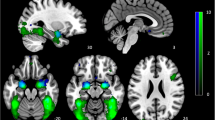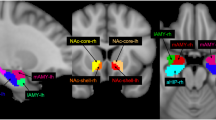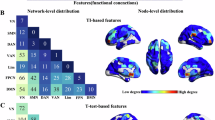Abstract
The syndromic heterogeneity of major depressive disorder (MDD) hinders understanding of the etiology of predisposing vulnerability traits and underscores the importance of identifying neurobiologically valid phenotypes. Distinctive fMRI biomarkers of vulnerability to MDD subtypes are currently lacking. This study investigated whether remitted melancholic MDD patients, who are at an elevated lifetime risk for depressive episodes, demonstrate distinctive patterns of resting-state connectivity with the subgenual cingulate cortex (SCC), known to be of core pathophysiological importance for severe and familial forms of MDD. We hypothesized that patterns of disrupted SCC connectivity would be a distinguishing feature of melancholia. A total of 63 medication-free remitted MDD (rMDD) patients (33 melancholic and 30 nonmelancholic) and 39 never-depressed healthy controls (HC) underwent resting-state fMRI scanning. SCC connectivity was investigated with closely connected bilateral a priori regions of interest (ROIs) relevant to MDD (anterior temporal, ventromedial prefrontal, dorsomedial prefrontal cortices, amygdala, hippocampus, septal region, and hypothalamus). Decreased (less positive) SCC connectivity with the right parahippocampal gyrus and left amygdala distinguished melancholic rMDD patients from the nonmelancholic rMDD and HC groups (cluster-based familywise error-corrected p⩽0.007 over individual a priori ROIs corresponding to approximate Bonferroni-corrected p⩽0.05 across all seven a priori ROIs). No areas demonstrating increased (more positive) connectivity were observed. Abnormally decreased connectivity of the SCC with the amygdala and parahippocampal gyrus distinguished melancholic from nonmelancholic rMDD. These results provide the first resting-state neural signature distinctive of melancholic rMDD and may reflect a subtype-specific primary vulnerability factor given a lack of association with the number of previous episodes.
Similar content being viewed by others
Log in or create a free account to read this content
Gain free access to this article, as well as selected content from this journal and more on nature.com
or
References
Amaral DG, Price JL (1984). Amygdalo-cortical projections in the monkey (Macaca fascicularis). J Comp Neurol 230: 465–496.
Beck AT, Steer RA, Brown GK (1996) Beck Depression Inventory-II. Psychological Corporation: San Antonio, TX.
Beck AT, Steer RA, Carbin MG (1988). Psychometric properties of the Beck Depression Inventory: twenty-five years of evaluation. Clin Psychol Rev 8: 77–100.
Burcusa SL, Iacono WG (2007). Risk for recurrence in depression. Clin Psychol Rev 27: 959–985.
Carmichael ST, Price JL (1996). Connectional networks within the orbital and medial prefrontal cortex of macaque monkeys. J Comp Neurol 371: 179–207.
Chao-Gan Y, Yu-Feng Z (2010). DPARSF: a MATLAB toolbox for ‘pipeline’ data analysis of resting-state fMRI. Front Syst Neurosc 4: 13.
Craddock RC, Holtzheimer PE, Hu XP, Mayberg HS (2009). Disease state prediction from resting state functional connectivity. Magn Reson Med 62: 1619–1628.
Cullen KR, Klimes-Dougan B, Muetzel R, Mueller BA, Camchong J, Houri A et al (2010). Altered white matter microstructure in adolescents with major depression: a preliminary study. J Am Acad Child Adolesc Psychiatry 49: 173–183.e171.
Dagli MS, Ingeholm JE, Haxby JV (1999). Localization of cardiac-induced signal change in fMRI. Neuroimage 9: 407–415.
Downing PE, Chan AW, Peelen MV, Dodds CM, Kanwisher N (2006). Domain specificity in visual cortex. Cereb Cortex 16: 1453–1461.
Drevets WC, Savitz J, Trimble M (2008). The subgenual anterior cingulate cortex in mood disorders. CNS Spectrums 13: 663–681.
Dutta A, McKie S, Deakin JFW (2014). Resting state networks in major depressive disorder. Psychiatry Res 224: 139–151.
Ebert D, Martus P, Lungershausen E (1995). Change in symptomatology of melancholic depression over two decades. Psychopathology 28: 273–280.
Elliott R, Zahn R, Deakin JFW, Anderson IM (2011). Affective cognition and its disruption in mood disorders. Neuropsychopharmacology 36: 153–182.
First MB, Spitzer RL, Gibbon M, Williams JBW (2002) Structured Clinical Interview for DSM-IV-TR Axis I Disorders, Research Version, Patient Edition. (SCID-I/P). Biometrics Research, New York State Psychiatric Institute: New York, NY.
Fox MD, Raichle ME (2007). Spontaneous fluctuations in brain activity observed with functional magnetic resonance imaging. Nat Rev Neurosci 8: 700–711.
Friston KJ, Williams S, Howard R, Frackowiak RSJ, Turner R (1996). Movement-related effects in fMRI time-series. Magn Reson Med 35: 346–355.
Gaffrey MS, Luby JL, Botteron K, Repovš G, Barch DM (2012). Default mode network connectivity in children with a history of preschool onset depression. J Child Psychol Psychiatry 53: 964–972.
Gardini S, Cornoldi C, De Beni R, Venneri A (2006). Left mediotemporal structures mediate the retrieval of episodic autobiographical mental images. Neuroimage 30: 645–655.
Green S, Lambon Ralph MA, Moll J, Deakin JFW, Zahn R (2012). Guilt-selective functional disconnection of anterior temporal and subgenual cortices in major depressive disorder. Arch Gen Psychiatry 69: 1014–1021.
Greicius MD, Flores BH, Menon V, Glover GH, Solvason HB, Kenna H et al (2007). Resting-state functional connectivity in major depression: abnormally increased contributions from subgenual cingulate cortex and thalamus. Biol Psychiatry 62: 429–437.
Hecht H, van Calker D, Berger M, von Zerssen D (1998). Personality in patients with affective disorders and their relatives. J Affect Disord 51: 33–43.
Herringa RJ, Birn RM, Ruttle PL, Burghy CA, Stodola DE, Davidson RJ et al (2013). Childhood maltreatment is associated with altered fear circuitry and increased internalizing symptoms by late adolescence. Proc Natl Acad Sci USA 110: 19119–19124.
Hyett MP, Breakspear MJ, Friston KJ, Guo CC, Parker GB (2015). Disrupted effective connectivity of cortical systems supporting attention and interoception in melancholia. JAMA Psychiatry 72: 350–358.
Johansen-Berg H, Gutman DA, Behrens TEJ, Matthews PM, Rushworth MFS, Katz E et al (2008). Anatomical connectivity of the subgenual cingulate region targeted with deep brain stimulation for treatment-resistant depression. Cereb Cortex 18: 1374–1383.
Kondo H, Saleem KS, Price JL (2003). Differential connections of the temporal pole with the orbital and medial prefrontal networks in macaque monkeys. J Comp Neurol 465: 499–523.
Kruschwitz JD, Walter M, Varikuti D, Jensen J, Plichta MM, Haddad L et al (2014). 5-HTTLPR/rs25531 polymorphism and neuroticism are linked by resting state functional connectivity of amygdala and fusiform gyrus. Brain Struct Funct 220: 2373–2385.
Kupfer DJ (1991). Long-term treatment of depression. J Clin Psychiatry 52 (Suppl): 28–34.
Liston C, Chen AC, Zebley BD, Drysdale AT, Gordon R, Leuchter B et al (2014). Default mode network mechanisms of transcranial magnetic stimulation in depression. Biol Psychiatry 76: 517–526.
Mayberg HS (2003). Modulating dysfunctional limbic-cortical circuits in depression: towards development of brain-based algorithms for diagnosis and optimised treatment. Br Med Bull 65: 193–207.
Meyer-Lindenberg A, Weinberger DR (2006). Intermediate phenotypes and genetic mechanisms of psychiatric disorders. Nat Rev Neurosci 7: 818–827.
Moll J, Zahn R, de Oliveira-Souza R, Krueger F, Grafman J (2005). Opinion: the neural basis of human moral cognition. Nat Rev Neurosci 6: 799–809.
Murphy K, Birn RM, Bandettini PA (2013). Resting-state fMRI confounds and cleanup. Neuroimage 80: 349–359.
Pizzagalli DA, Oakes TR, Fox AS, Chung MK, Larson CL, Abercrombie HC et al (2004). Functional but not structural subgenual prefrontal cortex abnormalities in melancholia. Mol Psychiatry 9: 393–405.
Power JD, Barnes KA, Snyder AZ, Schlaggar BL, Petersen SE (2012). Spurious but systematic correlations in functional connectivity MRI networks arise from subject motion. Neuroimage 59: 2142–2154.
Power JD, Mitra A, Laumann TO, Snyder AZ, Schlaggar BL, Petersen SE (2014). Methods to detect, characterize, and remove motion artifact in resting state fMRI. Neuroimage 84: 320–341.
Pulcu E, Lythe KE, Elliott R, Green S, Moll J, Deakin JFW et al (2014). Increased amygdala response to shame in remitted major depressive disorder. PLoS One 9: e86900.
Ressler KJ, Mayberg HS (2007). Targeting abnormal neural circuits in mood and anxiety disorders: from the laboratory to the clinic. Nat Neurosci 10: 1116–1124.
Roiser JP, Levy J, Fromm SJ, Nugent AC, Talagala SL, Hasler G et al (2009). The effects of tryptophan depletion on neural responses to emotional words in remitted depression. Biol Psychiatry 66: 441–450.
Sheline YI, Price JL, Yan Z, Mintun MA (2010). Resting-state functional MRI in depression unmasks increased connectivity between networks via the dorsal nexus. Proc Natl Acad Sci USA 107: 11020–11025.
Siegle GJ, Carter CS, Thase ME (2006). Use of FMRI to predict recovery from unipolar depression with cognitive behavior therapy. Am J Psychiatry 163: 735–738.
Tzourio-Mazoyer N, Landeau B, Papathanassiou D, Crivello F, Etard O, Delcroix N et al (2002). Automated anatomical labeling of activations in SPM using a macroscopic anatomical parcellation of the MNI MRI single-subject brain. Neuroimage 15: 273–289.
Vogt BA, Pandya DN (1987). Cingulate cortex of the rhesus monkey: II. Cortical afferents. J Comp Neurol 262: 271–289.
Windischberger C, Langenberger H, Sycha T, Tschernko EM, Fuchsjäger-Mayerl G, Schmetterer L et al (2002). On the origin of respiratory artifacts in BOLD-EPI of the human brain. Magn Reson Imaging 20: 575–582.
Zahn R, Lythe KE, Gethin JA, Green S, Deakin JFW, Workman CI et al (2015). Negative emotions towards others are diminished in remitted major depression. Eur Psychiatry 30: 448–453.
Zahn R, Moll J, Paiva M, Garrido G, Krueger F, Huey ED et al (2009). The neural basis of human social values: evidence from functional MRI. Cereb Cortex 19: 276–283.
Zamoscik V, Huffziger S, Ebner-Priemer U, Kuehner C, Kirsch P (2014). Increased involvement of the parahippocampal gyri in a sad mood predicts future depressive symptoms. Soc Cogn Affect Neurosci 9: 2034–2040.
Acknowledgements
JM was supported by the LABS-D'Or Hospital Network, Rio de Janeiro, Brazil. JAG was funded by an Engineering and Physical Sciences Research Council (EPSRC) PhD studentship. RZ was funded by a Medical Research Council (MRC) Clinician Scientist Fellowship (G0902304).
Author information
Authors and Affiliations
Corresponding author
Additional information
Supplementary Information accompanies the paper on the Neuropsychopharmacology website
Supplementary information
PowerPoint slides
Rights and permissions
About this article
Cite this article
Workman, C., Lythe, K., McKie, S. et al. Subgenual Cingulate–Amygdala Functional Disconnection and Vulnerability to Melancholic Depression. Neuropsychopharmacol 41, 2082–2090 (2016). https://doi.org/10.1038/npp.2016.8
Received:
Revised:
Accepted:
Published:
Issue date:
DOI: https://doi.org/10.1038/npp.2016.8
This article is cited by
-
AI-based dimensional neuroimaging system for characterizing heterogeneity in brain structure and function in major depressive disorder: COORDINATE-MDD consortium design and rationale
BMC Psychiatry (2023)
-
The relationship between resting-state functional connectivity, antidepressant discontinuation and depression relapse
Scientific Reports (2020)



